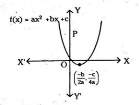
Q). If n is a natural number, then 6 n – 5n always ends with
A) 7
B) 5
C) 3
D) 1
Q). If n(A) = 5, n(B) = 5 and n(A ∪ B) = 8, then n(A ∩ B) =
A) 2
B) 3
C) 1
D) None
Q). If A = {x/x ∈ N, I < x < 10}, then n(A) =
A) 3
B) 4
C) 8
D) None
Q). Identify the disjoint sets among the following:
A) A-B, B-A
B) A-B, A
C) B-A, B
D) None
Q). If two zeroes of the polynomial x3 + 3 x2 – 5x – 15 are √5 and – √5, then its third zero is
A) 3
B) 5
C) -3
D) -5
Q). If α and β are the zeroes of the polynomial f(x) = a x2 + bx +c, then 1/α + 1/β =
A) b/c
B) –b/c
C) c/b
D) –c/b
Q). If the diagram shows the graph of the polynomial f(x) = a x2 + bx + c, then

A) a > 0, b < 0 and c > 0
B) a < 0, b < 0 and c < 0
C) a < 0, b > 0 and c > 0
D) a < 0, b > 0 and c < 0
Q). If x = 2 + 22/3 + 21/3, then the value of x3 – 6 x2 + 6x =
A) 3
B) 1
C) 2
D) -2
Q). If am ≠ bl, then the system of equations ax + by = c, lx + my = n
A) has a unique solution
B) has no solution
C) has infinitely many solutions
D) has two solutions
Q). The area of the triangle formed by the lines y = x, x = 6 and y = 0 is
A) 36 sq. units
B) 72 sq. units
C) 9 sq. units
D) 18 sq. units
